|
|
|
DECORATIVE ARTS
|
|
|
|
|
Click on images for more views
|
|
|
|
|
|
|
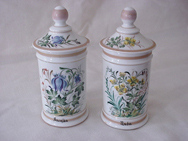
Click on image for more views
|
Hand-Painted Porcelain Apothecary Jars
These small unmarked porcelain apothecary jars are hand-painted with lovely realistically rendered botanicals and the painting is supurb! The colors, rendering, shading and composition are equal in quality to very fine 19th Century botanical drawings. One jar is inscribed with the herb 'Ruda' and the other with 'Ancollia'. Ruda is the Spanish term for the herb Rue or 'Ruta Graveolens', which is the botanical term. Rue was brought to North America by the Spanish conquistadors and was originally native to the Mediterranean area, although it is now cultivated in other parts of the world. The other term came up with nothing in my research. Being a Spanish term, may point to a Spanish origin, perhaps Northern Spain or South of France. These are classic apothecary jar forms, although somwhat smaller in size than usual. The bands of terra cotta is actually a copper luster glaze, reminiscent of the Hispano-Moresque pottery glazes. They are 6 1/4 inches tall and are in perfect condition. Given their high quality of artistry and finding a nearly identical one pictured in "Apothecary Jars" by Rudolf E.A. Drey, my guess is that they are from mid-late19th century France or Portugal.
|
|
Item #da014
—SOLD—
|
|
|
|
|
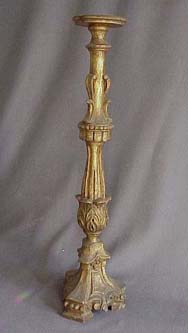
Click on image for more views
|
Early Carved Wood Gold Gilt Pricket Stick
This is a very old piece and has the patina that shows it. It was acquired in San Diego and likely came out of an old Catholic mission either in California or Central America. It is a European piece, likely Italian 18th-19th Century. Pricket sticks were used before electricity to illuminate a chapel or sanctuary in a church. They usually were made and used in pairs. Originally, it had an iron spike protruding from the hole on top on which to hold a large candle. It is hand-carved from wood and covered with gold gilt paint. There is a round molten-caste metal weight, which appears to be painted lead, screwed into the bottom to add ballast to the stick for stability. The screws are clearly of a later date, and it is unclear whether this metal weight is original or added at a later date. Considering it's age, it is in pretty good condition. Most of the gold gilt is in tact, the feet have some chips of wood broken off along the grain of the wood which is hardly noticeable. If viewed with a loop or magnifying glass, one can see the old crusty patina that can only come with age. The paint is cracked and chipped off in some places, and there is some old wax buildup on the base. The stick is 29 1/2 inches or 75 cm high.
|
|
Item #da012
$695
|
|
|
|
|
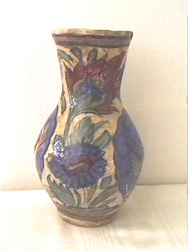
Click on image for more views
|
Late 19th-Early 20th C. Pottery Persian Vase
Date: Late 19th-Early 20th Century
Size: 6 7/8" high
This Iranian Persian-style vase is hand-made and hand-painted in floral and bird motifs. Although not as finely painted as some of the older Iznik pieces from old Persia, it is none-the-less an attractive and very decorative piece, and would make a nice addition to any art pottery collection.
Other Key Words: Persia, Iran, Middle East, Islam, Islamic, Muslem, Art Pottery, Ottoman Empire
|
|
Item #da01
$150
|
|
|
|
|
|
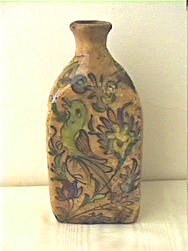
Click on image for more views
|
Late 19th-Early 20th C. Persian Pottery Vessel Bottle
Date: Late 19th C.-Early 20th C.
Size: 7 7/8" high
This Iranian Persian-style vase is hand-made and hand-painted in floral and bird motifs. Not as finely painted as some of the older Iznik pieces from old Persia, yet an attractive and unusual decorative piece with some artistic merit.
It has an unusual three-sided form, and has a very old-looking patina. The glaze is intact but rather crackled. At first glance, one would think it is a much older piece, but apparently these kinds of wares were and are still being made in Iran today. With the influx of Iranian immigrants to the US over the past few decades, these wares have been more available here. This and ane one above were acquired in San Diego, California where there is a large population of Iranian immigrants.
Other Key Words: Persia, Iran, Middle East, Islam, Islamic, Muslem, Art Pottery, Ottoman Empire
|
|
Item #da07
$150
|
|
|
|
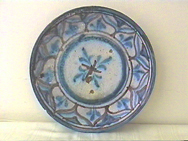
Click on image for more views
|
Early Middle Eastern or Persian Pottery Bowl
This bowl was given to my family in the late 1960's from a visiting professor from Azerbaydzhan, then a republic of the Soviet Union, located on the Northern border of Iran on the Caspian Sea. My guess is it is likely Iranian, Persian if older, possibly Syrian, and likely made in the late 19th to early 20th Century. It is similar in style and coloration to the old Persian Iznik pottery of the 16th-17th Centuries but less refined in technique and design. It is hand-painted in three colors of glaze, white, turqoise and brownish-purple. It has the three unglazed spots in the center of the bowl where the spacers where placed between the objects when stacking them in the kiln for firing. The rim design is a series of nine classic Islamic motifs, the center design a cross with surrounding quadrant of foliage. The clay color is light terra cotta. Is in in very good condition, with one half inch chip in the center of the bowl, and one clay chip on the rim along with a few minor glaze chips. It has an 1/8 inch foot, is 10 1/4 inches in diameter, and about 1 1/2 inches deep.
|
|
Item #da06
$495
|
|
|
|
|
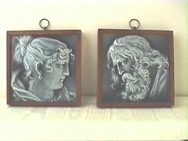
Click on image for more views
|
Pair of19th C. Minton Ceramic Portrait Tiles of Athena & Zeus
Date: late 19th C.
Size: Athena 6 3/8" square frame; Zeus 6 1/2 " square frame.
This pair of tiles was probably made by Minton, an English producer of fine quality ceramic ware. They excelled in monotone portrait tiles. The detailing on these tiles is exquisite and the delicate shading of the single color of glaze rendered in a painterly manner due to the portrait in relief is amazing in it's depth and volume. Each tile is framed in a mahogany frame with a metal loop hanger. The frames are completely enclosed with wood on the back and so I have not seen whether these tiles are marked or not. Note that the frame sizes are slightly different. |
|
Item #: da10
—SOLD—
|
|
|
|
|
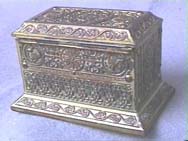
Click on image for more views
|
Vintage Japanese Cigarette Dispenser
Date: 1940's - 1950's
Size: 2 3/8" high, 3 1/2" wide at the base and 2 1/4" deep at the base
Description: This interesting vintage item of smoking paraphernalia, a cigarette dispenser, is made in the form of an Egyptian sarcophagus. These kinds of objects of this time period, the 1940's - 50's, tended toward the humorous to the absurd, with the sense of humor often being dark, morbid or obscene. This piece, with the obvious dark humor, is actually very tasteful and aesthetically done, with classical Egyptian motifs of griffins, winged lions, floral roundels and meandering foliage. The piece is made of coated metal appearing to be copper and brass. The hinged lid opens to reveal a slanted bottomed chamber with a width to accommodate unfiltered or hand-rolled cigarettes. There is a small knobbed lever on the lower right front which flips open a horizontal flap to dispense the cigarette., which is then caught by two protruding curved pegs. The piece was made in Japan and has a makers mark, which is an M enclosed in a diamond, four Japanese characters and the No. 151158. The box has a very nice heavy weight to it, and it has a nice old patina, worn naturally where the object has been handled over years of use. It is in excellent condition, and only has one small spot on the bottom where the painted coating has peeled away on the flat surface, which appears to have been differently done than the outer surface.
|
|
Item #: da11
$95
|
|
|
|
|
|
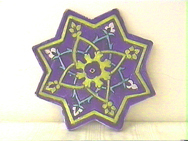
Click on image for more views
|
Late 19th-Early 20th C. Afghanistan Islamic 8-Point Star Tile
This beautiful hand-painted Islamic cobalt blue and yellow eight-pointed star tile came from Afghanistan. It is likely from the 19th Century or older. The design is lovely with a central yellow floral motif, two intertwined geometric four-point stars ending in floral buds, a four-color palette of yellow, turquoise and white against a beautifully vivid cobalt blue background. The piece is very decorative and can be used in a number of ways including being hung on the wall, resting on a plate shelf, or used as a trivet. This would make a lovely addition to someone's tile collection. Size is 9 inches from point to opposite point and 1/2 inch thick. See our other Islamic tile auction of a square tile of the same time period.
Condition: Excellent condition with only a few minor chips along the side edge and on one point tip, not detracting from the beauty of the tile. There is one small 1/8" surface ding where the glaze is chipped down to the clay, but it is at an intersection in the design and is hardly visible.
Keywords: ceramics, pottery, Arts and Crafts, Muslim, Central Asia, Persian, Arabic, Art Pottery, ceramic ware, decorative arts, tile collecting, tiles, ethnographic pottery, ethnographic tiles, ethnographic art, Islamic architecture, architectural elements, architecture, architectural design
on to a collection.
|
|
Item #: da08
—SOLD—
|
|
|
|
|
|
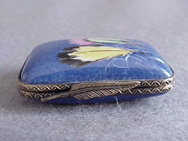
Click on image for more views
|
French Limoges Hand-Painted Porcelain Pill Box
Date: 1998 or earlier
Size: 2" wide by 1 3/8" deep by 5/8" high
This is a lovely hand-painted French Limoges cobalt blue porcelain pill box. The motif is feathers; two delicate hand-painted colored feathers on the lid, a small feather painted inside on the bottom surface, and the brass clasp along the rim is also a feather. The box is signed on the underside of the inside lid, saying "Peint main Limoges France". It is pillow-shaped. Excellent condition. Purchased in Paris in 1998.
|
|
Item #limogesbox01
—SOLD—
|
|
|
|
|
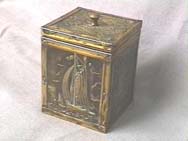
Click on image for more views
|
19th C. Brass Humidor or Tea Caddy
Date: late 19th C.
Size: 5 1/8" high by 4 inches square at base
This is a great old object with lots of character and patina. It is either a humidor or a tea caddy or tin. It is lined on the inside with tin and on the outside with embossed brass. The pattern on three of the sides and lid is a lovely intertwined Arabic or Oriental design. The front face is of an old wooden sailing ship at sea. The knob on the lid is held in place with a screw bolt and the linings are held with brass pins. It has a nice heavy weight to it. It appears to have had feet at one time.
|
|
Item #humid01
$165
|
|
|
|
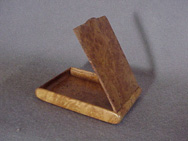
Click on image for more views
|
19th Century Russian Burl Wood Cigarette Case
Date: late 19th C.
Size: 4 3/8" long by 3 1/8" wide by 5/8" deep
This is a most amazing object, very elegant and well-crafted. The case is made from only two pieces of exquisite burl wood, perhaps maple or some other exotic light-colored wood from Russia. The box is carved from one piece of wood as is the lid. The dovetail hinge and edges of the lid fit together so perfectly that when closed, the case appears seamless. There are no straight lines when the box is closed, only soft rounded edges, making the case very pleasing to hold in the hands. The handle of the lid is elegantly curved, barely emerging from the edge, a subtle yet very functional design element which integrates beautifully with the design of the case. The hinge is so masterfully crafted and somewhat mysterious—the dovetailing between the lid and the box is as perfect and expertly crafted as it can be, clearly made by a master wood worker, and appears to be held together by hidden wire pins at each end, as there are two tiny filled pin holes at each end, barely visible to the naked eye. The entire surface of the case, both inside and out, is continuous, with the lovely burl wood grain visible throughout. This was obviously made for and used by someone of very discriminating and refined taste and sensibilities—not an object made for the common market, but rather made for the upper class. This would make a wonderful gift for that someone who loves to smoke for the pleasure of it and has very refined and discriminating taste. Needless to say, I recently saw a picture in a 2005 antiqes price guide of a very similarly made one, only with added silver and gemstone detailing on the handle, which was attributed to one of the Faberge craftsmen and identified as a snuff box (the hinge was on the long side). The wood and craftsmanship was identical to this one. It was priced at $3,000 - $4,000.
|
|
Item #wdcigbox
—SOLD—
|
|
|
|
 |
Vintage Leather Compact and Lipstick Case Set
This vintage compact set from the 1950's is in mint condition—never used, stored in it's original box for 50 plus years. The set is two pieces—a compact and a lipstick case. Both are covered with embossed leather. The compact has leather on both sides, a beveled mirror on the inside, and a powder puff compartment. The lipstick case also has a beveled mirror, has leather on one side and an exposed lipstick dipenser which clips to the mirror at the bottom. Both pieces are two inches square.
|
|
Item #lthrcmpct
$175#
|
|
|
|
|
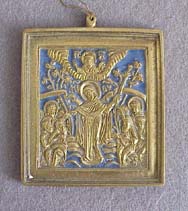
Click on image for more views
|
19th Century Russian Old Believer Travel Icon—Ascension
Metal icons were used mainly by the Old Believers, a sect of Russian Orthodox Christians who broke away from the main church because of unacceptable reforms put into place by the patriarch Nikon in the 1650's. As a result, they were persecuted and fled into the wildernesses to escape, starting their own monasteries and skites, from the17th Century through19th centuries. In 1723, Peter the Great declared an ukaz prohibiting the casting of metal icons. Despite the ban, icons continued to be produced in small monastery workshops and used for personal devotional practice in a variety of ways. The earlier ones were worn around the neck as amulets. They were used as portable travel icons, fastened to the gates of houses or grave crosses, wrapped in cloth and put into graves of loved ones. Those depicting patron saints were often given to soldiers and travelers for protection. The migration of the Old Believers was at its height in the nineteenth century, when persecution was particularly fierce during the reign of Tsar Nikolai I (1825-1855), thus moving further into Siberia, other remote areas and beyond the borders of Russia including Asia, Europe and Russian America (present-day Alaska). Current Old Believer communities in the United States have settled mainly in the states of Oregon and Alaska.
This 19th century travel icon depicts the Ascension of Christ. It is made from bronze and blue enamel. It is 2" x 2 1/4" or 5.2 x 5.7cm.
|
|
Item #da013
$360
|
|
|
|
|
|
|